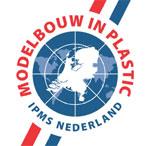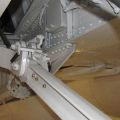The Vought F7U Cutlass was a United States Navy carrier-based jet fighter and fighter-bomber of the early Cold War era. Design V-366 was a highly unusual, semi-tailless design and pretty large. Pitch and roll control was provided by elevons, though Vought called these surfaces "ailevators" at the time. Slats were fitted to the entire span of the leading edge. The first XF7U-1 flew in September 1948.
Several versions were developed. The F7U-1 was very close to the 6 prototypes and 14 were built. The US Navy Flight Demonstration Squadron, the Blue Angels, flew two F7U-1 Cutlasses as a side demonstration during their 1953 show season but is was not a success. The next version was to be the F7U-2 but that was cancelled.
What followed was the F7U-3M that would be the definitive production version. It was siginificantly different from the F7U-1 with another nose profile and larger airframe with many more access doors for maintenance. The single nose wheel was soon replaced by a dual pair but still the nose gear gave problems. It also got 4 20mm guns in the upper intake lips. The later versions got other ejection seat and different wind shield. Also, a missile firing version was developed, the F7U-3M could fire the first generation Sparrow 1 missile with 4 pylons to be fitted. Some 50 earlier F7U-3 aircraft were modified to -3M standard.
Apart from the fighter, it was envisaged to use the Cutlass for photo reconnaissance. Some 6 reconnaissance F7U-3P aircraft were made with a 25" longer nose fitted with cameras. Guns were removed. First flight was July 1954. But in the end this version was only used for trials.
The Cutlass had a very long nose landing gear strut required for high angle of attack carrier landings and that gave many problems. Also, the aircraft was underpowered with its Westinghouse J46 jets and its afterburner reduced its range a lot. The type had also numerous technical issues like flame outs and handling problems. It was not liked by pilots as it had only little margin of error, killing many pilots in fatal accidents.
A total of about 28 F7U-1 and 274 F7U-3 aircraft were manufactured equipping a dozen U.S. Navy squadrons including later on some 50 converted F7U-3 to -3M standard. The Cutlass was mostly operated from shore, only a few deployments were made from US aircraft carriers and even than the type operated abroad from nearby shore bases. Eventually, the Cutlass served only a short period with the U.S. Navy and went out of service in 1957.

F7U-3
This aircraft with BuNo 129655, although marked as an F7U-3M, was first an F7U-3 which was factory upgraded to F7U-3M standards. This aircraft is one of the few survivors today and it is on display at the National Museum of Naval Aviation at NAS Pensacola, Florida.
Photographed January 2012 by Cees Hendriks (c) Copyright IPMS Nederland
Extra photo's :
Photographed January 2015 by Cees Hendriks (c) Copyright IPMS Nederland
TECHNICAL MANUAL INFORMATION
Illustrations selection F7U-3 from Flight Manual AN 01-45HFC-1 and Handbook Maintenance Instructions AN 01-45HFC-2.
Collection M. de Vreeze (used with permission)
This is old unconfidential material. Deviations on systems on real aircraft may occur.
Several scale models of the Cutlass exits. Very good 1/72 kits are from Fujimi. In 1/32 scale Fisher Model & Pattern had a very good resin F7U-3M kit. [external link]
This walk around page was first created May 2012 and written by Meindert de Vreeze

















































































































